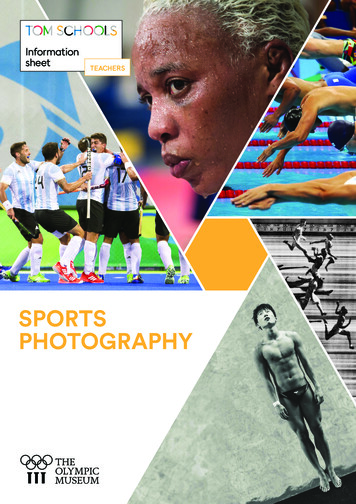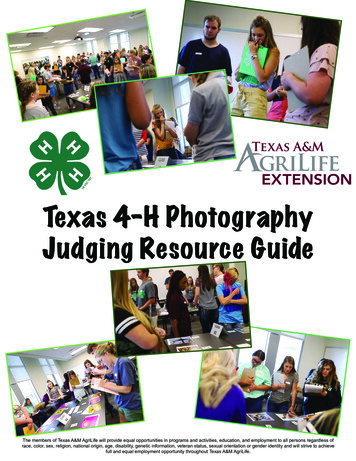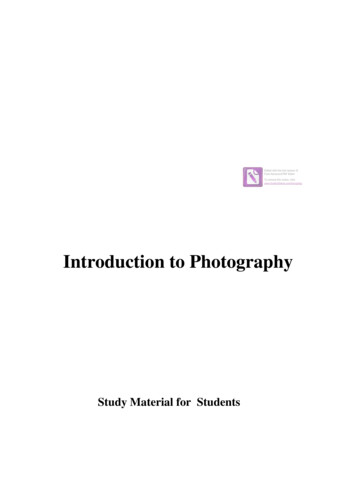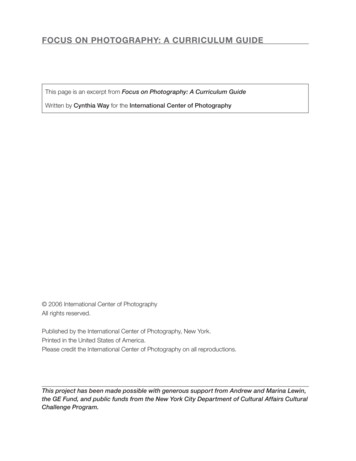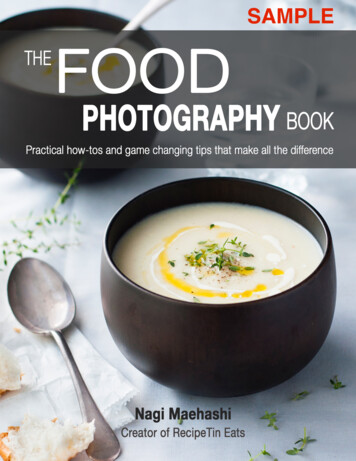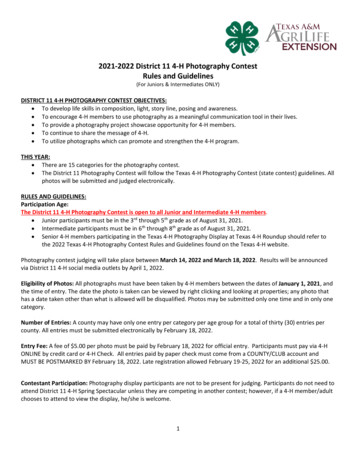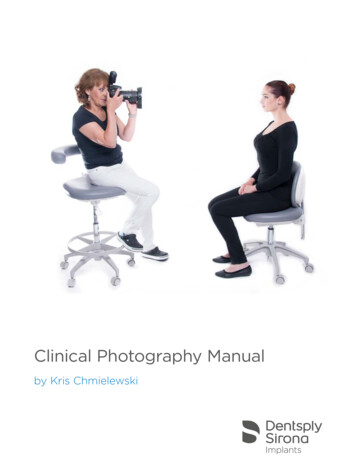
Transcription
Manuscripts & Photography4927 Edendale Court West Vancouver, BC V7W 3H7 CANADATel: 604.720.2000email: info@voyager-press.comFax: 604.922.2272
Terms of BusinessAll material is offered subject to prior sale. Prices are based in US Dollars. We acceptpayment in Euros, Pound Sterling, US and Canadian Dollars at prevailing ExchangeRates.We also accept payment by Visa, MasterCard, PayPal and Cheques.Libraries and Institutions may arrange deferred billing on request. All items remain theproperty of Voyager Press Rare Books & Manuscripts until payment is made in full.Purchases may be returned for any reason within ten (10) days of receipt for a fullrefund or credit, but please notify us of any returns in advance. Returns should beadequately packed and insured.Own a piece of history today!Voyager Press Rare Books & Manuscripts was established in 2001 by Bernie Lauser,and is based in Vancouver, BC – CanadaWe specialize in travel related manuscripts, photography and unique works onpaper. In addition, archives relating to travel and archaeology have recentlybecome one of our areas of focus.We attend several international book fairs annually to source and acquire significantitems for those seeking to “own a piece of history”!info@voyager-press.comTelephone 1.604.720.2000www.voyager-press.com
(MANUSCRIPT - ENGINEERING - GERMANY)DIESEL, RudolfInventor of Diesel EngineSigned Manuscript LetterEarly Prototype Plan DescribedUS 1,250[Berlin, 31 August 1895] - Rudolf Diesel's retained copy of hisown signed manuscript letter to Samuel Breslauer,concerning the installation of a gas engine. Text is inGerman. 4to. Two single leafs, 2 pages of text on onion skinpaper measuring approximately 30 x 24 cm. Minor agetoning, otherwise in very good condition.In this correspondence, Diesel describes alterations beingmade to the design of his first prototype, making commentson the compressor, transmission, and the lighting system(ignition), among other things. The second prototype,described here, would be built by October the same year.The specific plan for this engine model is noted in the uppermargin: Plan F.B.930.Rudolf Christian Karl Diesel (1858-1913), needing nointroduction, was a German inventor and mechanicalengineer who is world-famous for having invented theDiesel engine. At the time of this letter, Diesel was diligentlyworking on altering and perfecting his 1893 engine design.This design would later be known as the diesel engine.The first successful Diesel engine Motor 250/400, designedby Rudolf Diesel, was officially tested in 1897 by Germanindustrial engineer Moritz Schröter. Schröter concluded, "weare beholding a quite marketable machine that has beenthoroughly designed with great attention to every singledetail." At this time, several firms bought licences for buildinglegal copies of the Motor 250/400. It is now on display at theGerman Technical Museum in Munich.The first prototype Motor 150/400, had been completed 12July 1893. Initial tests proved it to be a successful concept.3
(MANUSCRIPT - PRIVATEERING - SCOTLAND)Primary Source AccountPrivateering in the American RevolutionLittle-Known Privateer BrigantineIn the Virginia State Navy'The Other Grand Turk'Seized by BritishNear Shetland IslandsUS 1,750[Scotland, 1783] - Manuscript deposition against thelittle-known Brigantine privateer 'Grand Turk' operatingunder letters of marque and reprisal for the VirginiaState Navy, which was spotted, chased and capturednear Scotland's Fair Isle by Michael Griff, Captain ofthe British privateer Tordenskjold. Folio. 2 pages in avery neat hand, recto and verso on a single leafmeasuring approximately 20cm x 32cm. Very goodcondition, a fascinating and detailed primary sourceaccount.The American privateer is a little-known and all-butforgotten brigantine that served the American War ofIndependence, deserving of its place in history. Not to beconfused with the famous Grand Turk from Salem, MA, thisbrigantine privateer was built for the Virginia State Navyand first commissioned on 1 October 1781 (only 14 weeksafter the famous vessel).According to the NRAR (Naval Records of the AmericanRevolution 1775-1788), being the authoritative source onhistoric vessels, Virginia State's brig Grand Turk wasequipped with 14 guns and manned by a crew of 60 menstrong. Her master was Cornelius Schermerhorn, whosemate was Walter Stephens of Philadelphia at the time oflaunching. She was bonded for 20,000 by Samuel Davisonand Joseph Carson, both of Philadelphia. Joseph Carsonwas also part owner of the vessel, together with John WrightStanly and George Emlen of Philadelphia.Excerpts from the Manuscript:"The Captn of the Privateer Michael Griff declared asfollows, that after he the compearent had left this with thePrivateer Tordenskjold, & got to sea on the 8th Inst. hesteered his course for Scotland. On the 11th the samemonth there was seen from the top of the privateer's mast,to the West, the America ship in question which happenedat 6 o'clock in the morning." [referring to the Americanprivateer Grand Turk, named later]4
(MANUSCRIPT – COURT DOCUMENT)American Brig “Eliza”Primary Source DocumentCaptured by Spanish PrivateerIn the Bay of AlgecirasRecaptured and Brought to Gibraltar* During the Battle of Algeciras Bay *US 1,750[Washington, D.C., November 1801 - ca. April 1802] Four manuscript court documents pertaining to anAmerican merchant ship captured in 1801 by aSpanish Privateer while on a voyage to Barcelona andMalaga with valuable cargo, the subsequentrecapture by the American crew, and claim forcompensation from the salvage of her cargo. Threefolio, one octavo, all single-leafs. Two documents aresplit at folds, one of which has very minor loss to text,otherwise the lot in very good condition, clean andlegible, a most interesting record of the event andproceedings in the Admiralty Court.Primary source accounts concerning a privateering andcounter-privateering event in the early nineteenth centuryprovide a glimpse into the sea-trade mindset including acompassionate take-over, sales of cargo salvage ascompensation to crew, and Admiralty Court proceedingsThe American Brig Eliza, formerly Schooner Maria, whosehomeport was Charleston and master was Captain JosephMichael, was destined for Barcelona and Malaga in June1801, with a cargo belonging to an American merchantnamed John Seamy. Near Tarifa, in Cádiz Province, on 10July she was seized by Spanish privateers and ordered tothe Port of Algeciras. While at anchor there, CaptainMichael, with the help of his crew, in particular a BenjaminHubble, managed to re-take the ship from the Spanish. Theyimmediately proceeded across the Bay to English Gibraltarwith the intention of selling the ship and cargo for personalgain.5
(MANUSCRIPT - SILK - JAPAN)Shunshô & ShigemasaCultivating Silk Worms12 Stages of Silk ProductionJapanese Colour Woodblock PrintsUS 3,750Kitao Shigemasa (1739-1820) andKatsukawa Shunshô (1725-1792)Kaiko Yashinaigusa (Cultivation of Silk Worms)A complete series of 12 Edo or Tokugawa Period) Japanese Woodblock Prints onChūban (sericulture (silk production), bound in book form andfirst produced in 1772 (Meiwa 9/An'ei 1) by KitaoShigemasa. Designed collaboratively with KatsukawaShunsho with six prints by Kitao Shigemasa and six byKatsukawa Shunshô. It was reprinted in 1776 and thenlater in 1786.中中The prints show the twelve stages of silk production,comprising:1) Laying eggs on a sheet of paper2) Picking mulberry leaves to feed larvae3) Transferring grown silkworms to other bamboo mats andfeeding them4) Re-activating worms after sleep5) Feeding larvae with mulberry leaves6) Placing cocoons on trays7) Arranging male and female moths to lay eggs8) Silkworm moth flying after hatching cocoon9) Hand-spinning thread from cocoons in a pan of boilingwater10) Stretching silk floss on wooden posts11) Spinning silk12) Weaving silk on loomThe 6 prints by Shunshô are nos. 1, 3, 6, 8, 11, 12The 6 Prints by Shigemasa are nos. 2, 4, 5, 7, 9, 10chuban tate-e: Image size (23cm x 17cm) - sheet size (30cmx 21cm)Very pleasingly bound in book form with silk cloth covers6
(AGRICULTURE - JAPAN)OKURA, NagatsuneWhale Oil as PesticideFirst Japanese Book on Crop ControlJokoroku - Destroying LocustsWoodblock IllustrationText in JapaneseUS 3,750Title: Jokoroku. [Removing Locusts][Edo: Okura Nagatsune, 1826] - A rare andrevolutionary work complete with woodblockillustration, proposing and demonstrating the use ofwhale oil as a pesticide for crops being destroyed bylocusts, this being the first Japanese book to describeagricultural pest control and pesticide. All text is inJapanese. 8vo. 72 pages including title page andsome form of index being the final leaf. Woodblockprint. 8 full-page illustrations, 2 double-pageillustrations, and 2 smaller ones within the text;chapters or subject matter printed to margins of eachleaf. Original blue paper boards, string-stitched atspine, and opening from left to right. Complete in asingle volume, measuring approximately 22,7 x 15,7 x5 cm. Indication of burrowing to first few leaves,otherwise in very good and original condition, Apleasing, exceedingly scarce volume.The first known printing of this work was in 1810, ofwhich only one existing copy is known. The presentvolume appears to be the second printing, withexpanded text and additional illustrations, and it too, isextremely rare. The wide-ranging dates between thetwo printings suggests possible increase or invasions oflocusts greatly affecting Japan's agricultural supply. Italso confirms that Okura's method of using whale oil toprotect crops from locust destruction was tested andindeed a viable solution."Okura's writings emphasized ways to make farming moreefficient and productive: timely cultivation, better seeds,better equipment, supplementary crops, and the care ofand culture of silkworms." - Jansen, The Making of ModernJapan, p. 209.7
(MANUSCRIPT - MARINE DOCUMENT - JAPAN)PERRY, Matthew C. CommodorePerry's 'Black Ships' in Edo BayUnique Manuscript Narrativewith Large Ink DrawingUS 5,500[Japan, circa July 1853] - Manuscript documentdescribing the great consternation among theJapanese civilians, upon the arrival of CommodorePerry's four American ships at Uraga in July 1853, andthe warlords' immediate action to guard the coast.Together with a large manuscript ink drawingdepicting the "black ships", and an accompanyingdrawing of a barrel transport method. All text is inJapanese. Minor creasing and age-toning, otherwiseitems are in very good condition, beautifully preservedcontemporary documentation by a Japanese civilianobserving the events as they unfolded.Document: 8vo. 11 pages in manuscript, written recto andverso to six folded leaves string-tied at margin. Documentmeasures approximately 28,5 x 18,5 cm.Drawings: Linen backed, folded leaf measuringapproximately 64 x 43 cm, accompanied by a relateddiagram on a single leaf measuring approximately 27 x 40cm.8
(MANUSCRIPT - MAP - JAPAN)Nanpo Islands - OgasawaraManuscript Watercolour MapJapan's First Overseas ColonyPossessions in the PacificAnijima, Chichijima, and Hahajimafor Settlement and AgricultureUS 2,750[Japan, circa 1863/64.] - Large manuscript map ofthe remote and mostly uninhabited Nanpo andOgasawara archipelagos, lying some 1000kilometers south of Tokyo, which had been claimedby the Tokugawa (Edo) shogunate in 1862. Title,descriptions, all text is in Japanese. Red inkdocketing stamp to lower margin. Map measuresapproximately 63,5 x 27,5 cm. Indication of minorburrowing though unobtrusive to image or text,professionally reinforced with clear bookbinder'stape to one margin, otherwise in very goodcondition, beautifully preserved, with vivid colourand manuscript detail in a fine hand.A most fascinating map produced shortly after theJapanese had claimed the islands in 1862, thecartographer's detail reveals that preliminary surveyinghad been done and colonizing was in consideration. Theislands are named, and the larger ones have areasdelineated for a specific purpose, specifically Chichijima,Anijima, and Hahajima. Communication routes betweenthe islands are clearly indicated. Mountain ranges arealso shown. An annotation describes the naturallysheltered bay of Minamijima island.9
(MANUSCRIPT - TEA - JAPAN)Urasenke School19th Century – Meiji PeriodBook on Tea CeremonyMeticulously Detailed with IllustrationsFirst Edition - 6 VolumesUS 1,275[Japan: Aoki Kozaburo, Meiji year 16-17 1883-1884] The traditional Japanese tea ceremony explained inmeticulous detail and profusely illustrated in a sixvolume teaching guide from the Urasenke school, oneof the main schools of Japanese tea ceremony. FirstEdition. 8vo. approximately 200 pages combined.Woodblock print. A complete set: First part Vol.1 Vol.2; Second part Vol.1 - Vol.2; Third part Vol.1 - Vol.2.In publisher's original string-stitched teal paper covers,each volume with original title slip. Very good andoriginal condition, a pleasing and complete work inexcellent state of preservation.The Japanese tradition is a ceremonial way of preparingand drinking green tea, typically in a traditional tearoomwith tatami floor. Beyond just serving and receiving tea, oneof the main purposes of the tea ceremony is for the gueststo enjoy the hospitality of the host in an atmosphere distinctfrom the fast pace of everyday life.The present volumes are a fine example of the earliestschool instruction of the important Japanese TeaCeremony, covering every little detail for creating theproper experience. From basic tea ceremony practices torefined atmospheres, illustrations show everything from tearoom plans, table settings, charcoal-related items, theserver's attire, furniture, tea pots, sweet-related items,numerous instruments for preparation and service, andmore.When these volumes were produced in 1883/84, theschool's headmaster (iemoto) was Jikisho Soshitsu (18521917), also known as Yumyosai. He was the twelfthgeneration head of the Urasenke Tradition. His wife Yukako,who used the name Shinseiin, taught tea at girl's schools, tothe imperial family and former nobility, in an effort topopularize tea ceremony among women.10
(MANUSCRIPT - NAVAL INTELLIGENCE - SINGAPORE)Singapore and Riau IslandsSecret Reconnaissance LettersBanker and Politician Kiyochika IwashitaText in JapaneseUS 5,750[Singapore, 1908-1913] - Lot of 21 manuscript letters, inan undeciphered Japanese script (possibly code),one of which contains a full-page manuscript mapdrawn by the writer, relating to clandestineinvestigations in the region, possibly reporting on areconnaissance mission for the purpose of establishinga Japanese naval base near Singapore or the RiauArchipelago. Written in Singapore, all addressed toprominent bank owner and statesman K. Iwashita,Esq., in Japan. Leafs vary in size; each isaccompanied by its original franked cover. Contentranges from 1 page to 4 pages. Occasional creasingand age-toning, mainly to envelopes, otherwise invery good condition, each item well preserved in itsindividual plastic sleeve together with cover. A mostintriguing lot of top-secret correspondence to bedeciphered by a scholar.The period in which this reconnaissance was taking place,and the fact that we cannot translate the texts, lead us tobelieve the letters contain sensitive information. Written inan ancient Japanese script, or possibly coded for secrecy,this correspondence may very well concern the scouting ofa suitable location for a Japanese naval base and supplyports, as well as an accessible route from the select locationto Singapore. The enclosed map reveals the specificlocation of interest, as well as proposed land and waterroutes for transportation of people or cargo. Nineteen ofthe letters span from 1908 to 1911 and are from the sameindividual. There are two letters dated 1913, at the dawn ofthe Great War, these two being from another writer.11
(WOMEN – SR. GEOGRAPHER’S SIGNED MEMBERSHIP)COLE, Monica MarySenior Female GeographerLeader in Scientific CommunityUS 125[London, 1942-43] - Two signed membership documentsformally accepting English geographer Monica MaryCole into two scientific societies for the learned, theRoyal Geographical Society and the Geologists'Association, respectively. 8vo. Two separate printeddocuments, three leafs combined, each documentcompleted, signed and dated by the respectivesociety's secretary. Leafs measure approximately 20,5 x26 cm. Creasing to one document, otherwise in verygood condition.Monica Mary Cole (1922-1994) was an English geographer,lecturer, and author, an intellectual woman and polyglot,whose legacy has been described by her colleagues as "aleader in her chosen field of academic research" who "scaledthe heights of a profession that, even today, finds too fewwomen as the incumbents of chairs." She left the RoyalGeographical Society 10,000 for it to establish a researchtravel grant for young female physical geographists.The Archives of the Royal Holloway, University of London holdsa collection of papers relating to Cole. They include herpersonal papers and objects connected to her career as ageographer between 1967 and 1970.During her distinguished career she produced pioneeringworks in the fields of biogeography and geobotany, remotesensing and terrain analysis, and mineral exploration. Herresearch spanned Central and Southern Africa, Brazil,Venezuela, Australia, China and Finland. Cole was not thearchetypal quiet and contemplative academic. She was alarger-than-life character, and people loved to be aroundher.She was elected as a Fellow in the Royal geographicalSociety on 22 June 1942. The following year, on 6 December1943, she also became an elected member of the Geologists'Association of London. The present documents are her officialmembership declaration papers from each of these societies.12
(MANUSCRIPT – AVIATION)Doris Dowser Todd, English GovernessPrimary Source Manuscript AccountFeaturing Pioneer AviatorsBlériot - Védrines - LeBlanc - BellengerWright BrothersLetter book of an English Governessat Pau - the Center of AviationUS 1,950[Pau, 16 September 1911 - 16 July 1912] - Manuscriptletter book containing primary source, contemporary,information on notable early aviators and fascinatingdescriptions by a first-time observer of the new airtravel inventions, written at Pau, France, the city wherethe Wright Brothers had established the first flyingschool in history just one year earlier, and where theaerospace industry was beginning to flourish, by DorisDowser Todd, English Governess to Dr. Louis Goudard,a founder of the Société Médicale de Pau et du Béarn.In this volume, Miss Todd has transcribed her ownletters, written to family, while in Pau, France. Towardsthe end of the volume she writes to a man of romanticinterest. 8vo. 152 pages in manuscript. Burgundy clothboards, initials and border blind stamped to front,ruled leaves with the globe motif watermark ofMidland Educational Company Birmingham. Insertedwithin the volume: one contemporary theatreprogram, one draft letter, one personalia documentdating to the Great War. Wear to boards, book blocksplit at hinge, otherwise internally in very goodcondition, a delightful account in a neat hand, by aninquisitive and enthusiastic young lady.The writer's arrival at Pau being only 2 years after the Wrightbrothers, and only 1 year after their founding of the world'sfirst aviation school, makes her primary source accountexceedingly scarce, being contemporary to the formationof flight training and some deadly experimentations whichclaimed the lives of gallant young pilots.". people come to Pau principally for the aviation now.There are about 50 officers learning to pilot aeroplanes. Allthe best French aviators are here now, Védrines, Leblanc,Bellanger."13
(MANUSCRIPT – WOMEN – CHINA)Alice A. HindmarshManuscript DiariesWoman Sailor on a Merchant BoatVancouver - Balboa - ShanghaiTrade RouteUS 1,250[Canada, USA, China, Trinidad, Barbados, 5 May - 26December 1931] - Manuscript travel diaries of Alice A.Hindmarsh who plied the seas on a small merchantvessel back and forth between the Pacific NorthwestCoast, Panama, and China, her husband evidentlybeing employed in the trade and working on thevessel. 8vo. 3 volumes, 423 pages combined (195, 159,69, respectively). Each volume unique, cloth boards,black, red, and blue, respectively. One blemish,otherwise only minor wear to exterior, and internallybright.The writer, Mrs. Alice A. Hindmarsh, lived at Sunnyside,Ryton-on-Tyne, Tyne and Wear, England, and travelledacross the Atlantic to Canada with another woman calledMadge. She embarked on a small merchant vessel, havingher own private quarters, to ultimately meet with herhusband Jack at Vancouver, Canada, and then travel withhim, to and fro on the Shanghai-Vancouver trade route.Jack was 42 years old, working in the trade. The early diaryentries suggest that he was completing his sea merchantschooling while she was on the first voyage to meet him inVancouver. He subsequently worked onboard the ship asthey sailed repeatedly between China and the PacificNorthwest Coast. He was knowledgeable and experiencedwith life a sea from earlier experiences. As a young ladapproximately 12 years old, he had been to Calcutta, forexample. Alice, too, had a passion for sea voyages, havingpreviously been to the West Indies and Brazil, and callingherself a "real sailor".Lumber was the cargo collected in Canada, bananas inPanama; while in China the remarkable sights and leisureactivities fill the diary pages.14
(MANUSCRIPT – WOMEN – WEST INDIES)Alice A. HindmarshManuscript DiaryWoman Sailor on a Merchant BoatPanama - West Indies - VancouverTrade RouteUS 750[Saint Thomas, Panama, Vancouver, 23 August - 21November 1932] - Manuscript travel diary of Alice A.Hindmarsh who made a round-trip voyage on a smallmerchant vessel from England to the Pacific NorthwestCoast, by way of Panama and the West Indies, herhusband being employed in the lumber trade andworking on the vessel. 8vo. 86 pages. Black clothboards. Volume measures approximately 25,5 x 20cm. Some wear to boards, a spill on upper margin offirst few leafs though unobtrusive to text, otherwise invery good condition, internally bright.The writer is Mrs. Alice A. Hindmarsh of at Sunnyside, Rytonon-Tyne, Tyne and Wear, England, and who's uniquevoyage was not on a cruiser, but rather onboard a smallmerchant vessel on which her husband Jack was employedin the global trade. Jack seems to be the Chief Officer,second in command after the Captain.15
(PHOTOGRAPHY - EGYPT)Portfolio of Photographs & DrawingsCairo - Luxor - AswanVisit to the Temple of PhilaeOnly Two Years after Hermann JunkerUS 2,750[Egypt, 1912] - A unique portfolio of photographs andmanuscript drawings from a pre-WWI German travellerwho visited Alexandria, Cairo, Siut [Asyut], Luxor[Thebes], and Assuan [Aswan]. Contains 73 gelatinsilver print photographs and 15 manuscript drawings three of which are painted with watercolours, allmounted onto large brown cardstock leaves to rectosonly. Half of the work relates to Aswan. Accompaniedby a manuscript index in German. Crown Folio. 40cardstock leaves measuring approximately 25 x 35,5cm. Photographs vary in size, most measuringapproximately 10 x 7,5 cm, with only a scant fewslightly smaller ones. Drawings vary in size, the smallestmeasuring approximately 9 x 11 cm, and the largestbeing a full page at 23,5 x 31,5 cm, several captionedand dated between 4-7 December 1912. Housed inthe traveller's lovely purpose-made clamshell box,green marbled paper boards, continental paperinterior lining, manuscript coloured map pasted tofront pastedown, measuring approximately 37 x 28 x 4cm. Wear to the clamshell box, particularly to cornersand spine, otherwise in Very Good Condition, itscontents very well preserved, a most impressivecompilation of striking photographs and skilleddrawings from an early tour of Egypt.This early foreigner's tour of Aswan, particularly Philae andElephantine Island, is visually and uniquely documentedwith snapshot photographs and stellar drawing art,providing views and perspectives contemporary to the firstmonumental archaeological works at Philae, thuspreserving for us images of the ancient structures in theoriginal place and condition as seen by Hermann Junkerand others only two years prior.16
(MANUSCRIPT - BIOLOGY - FUNGI)Album of Meticulous WatercoloursMycetozoa - Slime MoldAn Uncommon StudyUS 1,750[United Kingdom, circa 1930] - Journal of watercoloursand manuscript drawings, meticulously illustratingspecies of the Mycetozoa, featuring manuscriptdescriptions and scientific names in an equally pristinehand, complete with manuscript index. Containing 18large illustrations on rough-trimmed art papermeasuring approximately 20 x 28 cm, two leafsbearing the embossed stamp of the Royal WatercolourSociety at Pall Mall, each leaf mounted recto only to aleaf of the album. With an additional 6 smallwatercolour illustrations mounted to the final leaf.Quarto album measuring approximately 25 x 33 cm,red cloth boards fastened with two metal posts. Boardsfaded, wear to spine and extremities, otherwise in verygood condition.Slime molds were formerly classified as fungi but are nolonger considered part of that kingdom. Slime mold or slimemould is an informal name given to several kinds ofunrelated eukaryotic organisms that can live freely as singlecells, but can aggregate together to form multicellularreproductive structures. More than 900 species of slimemold occur globally.Mycetozoa is a polyphyletic grouping of slime molds. It wasoriginally thought to be a monophyletic clade, but recentlyit was discovered that protostelia are a polyletic groupwithin Conosa. These macroscopic organisms belong to theKingdom Protista, which includes all eukaryotes that are notanimals, plants, or fungi.17
(MANUSCRIPT - DRAWINGS - FRANCE)MARIN-MARIEFamous Painter and Yachtsman6 Manuscript Signed Letters”Wind Aloft Wind Alow” and”Carnet de Dessins”US 975[Paris, New York, 1933-1983. Archive of 6 manuscriptletters, four of which are signed, and 2 famouspublished works of Marin-Marie, including the secondEnglish edition of his Wind Aloft Wind Alow, the firstedition of a post-humous collection of his sketchestitled Carnet de Dessins, the correspondence beingwritten by him to John "Jack" T. Ackerson of NewJersey.The archive includes:"Wind Aloft": New York, Charles Scribner's Sons, 1947. 8vo. x,322 pages, blue cloth boards gilt titled to spine, completewith dustjacket. Text is in English. Volume measuresapproximately 15 cm x 22 cm x 3 cm. Some wear and chipsto dustjacket, protected in mylar, otherwise in very goodoriginal condition."Marin-Marie, 1901-1987: Carnet de Dessins": First Edition.Paris, Yves de Saint Front, 1983. Oblong 8vo. 95 pagesincluding the frontis, title page, and list of illustrations.Decorated boards and matching slipcase illustrative of apainter's canvas drop cloth. Text is in French. Volumemeasures approximately 28 cm x 23 cm x 2 cm. A rarevolume in fine original condition.6 Manuscript letters, four of which are signed "Marin": 8vo.15 pages in manuscript, combined. Single-leafs, one writtenrecto only, all others written recto and verso. Together withone of the covers, postage excised, showing the recipient'sname and address. Leafs bear the printed address 2 RueMeissonier XVII E. [Paris] and measure approximately 22 cmx 27 cm, with exception of one smaller leaf being thestationery of the Hotel Brevoort on New York's Fifth Ave.Some creasing and chips at extremities, partial loss to oneof the signatures, otherwise in very good condition, withfascinating and relevant content.18
(MANUSCRIPT – PASSPORT)Manuscript Passport - Travel in RussiaCaptain Younghusbandin Saint Petersburg and MoscowPrime Minister Lord SalisburyUS 750[London, 17 May 1890] - Original manuscript passportfor Captain George William Younghusband (18561897) of the Indian Army granting him permission totravel in Russia, he being the first cousin of Sir FrancisYounghusband who at the very same time was on amission to Chinese Turkestan and Hunza to gather intelon Russian activities, with the aim of opening AngloRusso trade agreements. Featuring with the stampedsignature of Lord Salisbury, Prime Minister of the UnitedKingdom, steel engraved armorial illustrations toheader and footer, several Russian stamps andsignatures to verso, and the passport holder's originalsignature. Printed text is in English. With annotationsand official entry stamps in Russian, including onemade at Saint Petersburg approximately 24 Februaryand another at Moscow 18 October 1890. Single leaf,with the watermark of J. Whatman and the year 1890,measuring approximately 38 x 28 cm. Creased,otherwise in very good condition, beautifullypreserved, clean and bright.The passport holder, Captain George WilliamYounghusband (1856-1897), served with the 34th Regiment,2nd Punjab Cavalry. The present numbered passportpermitted him to travel on the continent including in Russia.Issued at London on 17 May 1890 with the stampedsignature of Lord Salisbury, Prime Minister of the UnitedKingdom, this rare document features original Russianstamps and signatures.19
(ARCHIVE – PASSPORTS – EASTERN EUROPE)Unusual Passport Archive19th Century Travels to RussiaWWI German Occupation PassesRare Yiddish Passport - Eastern EuropeUS 2,750[Russia, Serbia, Germany, Lithuania, England, France,1846-1969] - Lot of 15 unique passports from variouscountries, featuring the occupied Baltics during theGreat War, nineteenth century travellers to Russia,some notable names, and assorted matters of interest.Some were issued for one specific journey, others forlonger term open travel, with examples concerningcitizenship and immigrant travel. These documentsvary greatly in format, including early and large singleleaf printed declarations completed and signed inmanuscript, to modern day wallet-sized hardcoverportfolios. Some creasing and
Voyager Press Rare Books & Manuscripts was established in 2001 by Bernie Lauser, and is based in Vancouver, BC – Canada We specialize in travel related manuscripts, photography and unique works on paper. In addition, archives relating to travel and ar
